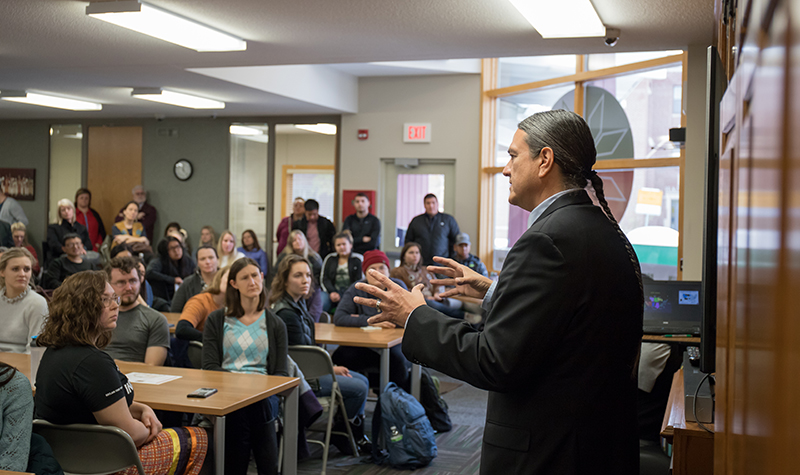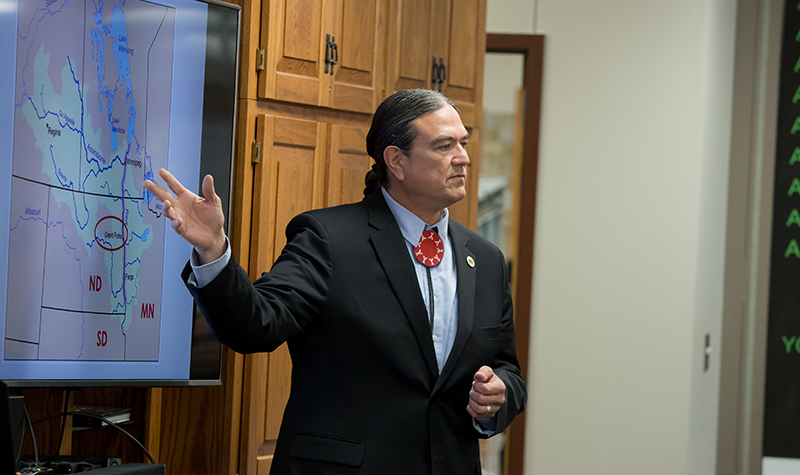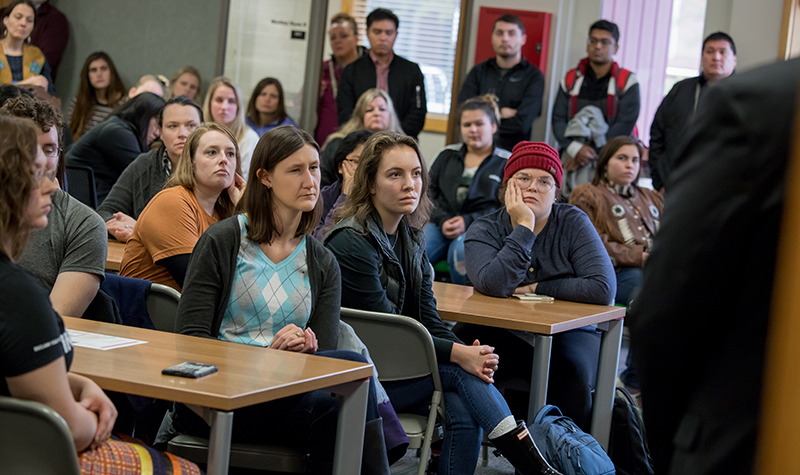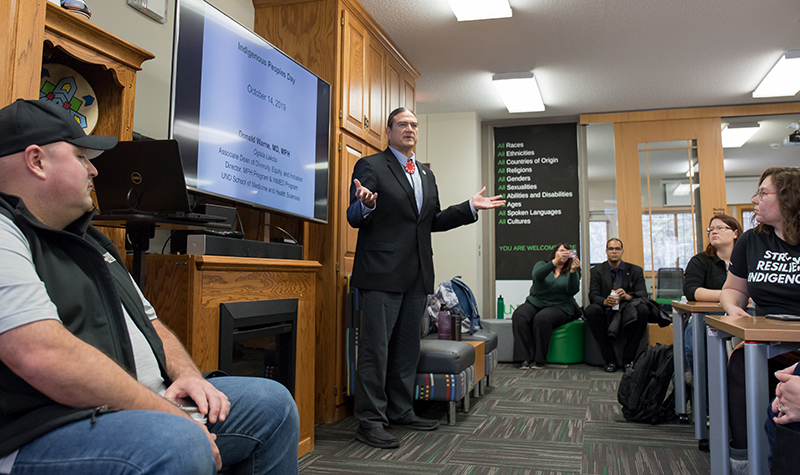21 Oct UND’s approach to American Indian health issues stands out, says Dr. Donald Warne during Indigenous Peoples’ Day talk

Associate Dean of UND’s School of Medicine & Health Sciences, Dr. Donald Warne, spoke to a max-capacity audience at the American Indian Center, marking Indigenous Peoples’ Day. Photo by Connor Murphy/UND Today.
Nothing against Columbus. But if you’re skeptical or resentful of the fact that Grand Forks joined the list of 130 cities and eight states that replaced Columbus Day with Indigenous Peoples’ Day, then it’s important to understand that the change may help make America a better place.
That’s because it’s part of a broader effort to help us as Americans better understand our history, said Dr. Donald Warne, associate dean of the UND School of Medicine & Health Sciences and director of the Indians Into Medicine (INMED) program, speaking at an Indigenous Peoples’ Day event on campus.
“And a lot of our history is negative,” especially regarding American Indians, Warne said.
“I talk about these things not to make anyone feel bad. That is not the point.
“Instead, the point is that if we’re ever going to achieve equity across populations, we have to go through truth. We have to walk through truth – even when it’s difficult.”
Importantly, that understanding is growing, Warne said. And one of the places that’s building this understanding is UND.
Warne, a member of the Oglala Lakota tribe from Pine Ridge, S.D., is a graduate of the Stanford University School of Medicine and the Harvard School of Public Health. A crowd of about 100 people packed the UND American Indian Center on Monday to hear his Lunch & Learn talk.
“I’m so grateful to all of you here,” Warne said.
“It’s heartwarming to see so many people interested in Indigenous Peoples’ Day. This isn’t always the case when we go to other universities or other communities, so I’m just very pleased and honored to see so many of you here.”

Warne briefly traced his ancestry and background among a family of traditional healers in Kyle, S.D. Today, Warne is one of four American Indian medical school associate deans in the country. Photo by Connor Murphy/UND Today.
Origin story
Warne started by noting he’s from Kyle, S.D. “How many people have been to Kyle?” he asked, and about six hands went up. “Wow. That’s about six more than usual!” he said as the crowd laughed.
But small-town Kyle was a big influence on Warne, in part because it was a center of traditional American Indian healing. “I come from a ceremony family, a Sundance family, and I grew up understanding our traditional ways of medicine,” he said.
“And when I was a young man, I was actually – without really knowing it – doing an apprenticeship with my uncles.” They included healers Rick Two Dogs, Birgil Kills Straight and Ray Takes War Bonnet, “and I just didn’t realize how fortunate I was to have this training in traditional medicine and traditional ways when I was growing up.”
Then in college, Warne did well at Arizona State University, and a pre-med advisor asked him if he’d ever considered medical school.
“And my first thought was – and I even asked him – ‘Are there any Indian doctors?’” Warne said.
“I mean, I knew it wasn’t illegal for us to become doctors,” he said, drawing more laughter. “But it had never seemed real until I actually met an American Indian physician.”
Of course, that uncertainty was not surprising, given that to this day, “American Indians are about 2 percent of the U.S. population, but only 0.2 percent of physicians,” Warne said.
“We’re the most under-represented of the under-represented minority populations.” That fact has ripple effects up and down the medical field: “So, how many medical-school associate deans do you think are American Indian today?” he asked.
Here’s a hint: “You’re looking at 25 percent of them right now,” he said.
“Fortunately, one of the other three also is at UND: Dr. Joycelyn Dorscher, associate dean of admissions,” and an Anishinaabe family practice doctor.
“So 50 percent of the American Indian associate deans at a medical school are located right here. … That’s not a pat on the back. It’s kind of an indictment of the field.”

Part of Warne’s presentation was addressing the horrific truths of American history, with respect to its native populations. It wasn’t a tactic to make the audience feel badly, he said. Instead it was a recognition that acknowledging truth is among the first steps toward real equity among American citizens. Photo by Connor Murphy/UND Today.
Trail of Tears
And of the other forces in American society that have produced such inequities, starting with the history that was the major focus of Warne’s talk.
That history includes horrifying episodes such as the 1763 letters by Lord Jeffrey Amherst – the British Army officer for whom Amherst College and Amherst, Mass., are named – in which Amherst advocates biological warfare by writing, “Could it not be contrived to send the Small Pox among those disaffected tribes of Indians?”, and “You will do well to try to inoculate the Indians by means of Blanketts, as well as to try every other method that can serve to Extirpate this Execrable Race.”
And the Indian Removal Act, the 1830 law that brought about the Trail of Tears – the forced march of the Chickasaw, Chocktaw, Seminole, Cherokee and other American Indian tribes from the southeastern United States to Oklahoma and other points west.
During that exodus of some 50,000-plus people, starvation and disease claimed as many as 16,000 lives.
And the Dakota War of 1862, as part of which the Daily Republican of Winona, Minn., noted that the state of Minnesota’s reward for dead Indians had been increased to $200.
And the American Indian boarding school era, during which American Indian children were taken away from their homes and forced to abandon their traditional cultures and identities. By the way, that era is not ancient history, Warne pointed out. His own mother, who’s in her 80s, is a boarding-school survivor.
“Again, I don’t talk about this to make people feel bad,” Warne said.
“It’s just that we need to know the truth of our history, so that we can start to develop programs and strategies to improve our outcomes.”
When this history is coupled with the profound impacts that discrimination, extreme poverty and other adverse experiences have on children and adults, the net result is that “in many ways, we have Third World health conditions right here in North Dakota,” Warne said.
“I remind my colleagues and public-health academics that you do not have to cross an ocean to find Third World health conditions. It’s right down the highway.”
Health disparities, educational disparities, early death, difficult living circumstances — clearly, these are huge challenges, Warne said.
“So what do we do?”

Warne is leading efforts at the University to implement the world’s first Ph.D. in Indigenous Health, which follows UND’s creation of the nation’s first Master of Public Health in Indigenous Health – a program whose students study determinants of indigenous health and solutions to health disparities. Photo by Connor Murphy/UND Today.
‘An uprising of indigenous strength’
The answer, he said, starts with taking a comprehensive approach by looking at these issues from a medical, behavioral and public health perspective.
“And part of breaking down those barriers includes what we’re doing here in North Dakota,” he said.
For example, UND offers the nation’s first Master of Public Health in Indigenous Health degree, a program whose students study in detail determinants of indigenous health and solutions to health disparities.
“Starting next fall, we’ll also be offering a first in the world: a Ph.D. in Indigenous Health,” Warne said.
That program will be led by a staff of scholars that includes Drs. Siobhan Wescott (Athabascan), Melanie Nadeau (Ojibwe), Nicole Redvers (Dene’) and Ursula Running Bear (Sicangu Lakota).
“This is really unprecedented, in that indigenous scholars will be the lead educators and scholars focused on indigenous health,” Warne said.
Then there’s the INMED program, which is approaching its 50th anniversary and has graduated more than 240 Indian physicians since its founding in 1973.
“So, we have a challenging history,” Warne said.
“But we have a path forward. … There’s really a movement occurring here.”
From the old prophecies, the Lakota people were taught to pray seven generations ahead, Warne said as he concluded his talk.
“And I take a lot of strength and comfort in knowing that seven generations ago, they were praying for me, they were praying for you – for all of us.
“And seven generations ago, when they were going through all of those hardships that I described, there was a prophecy that seven generations from that time, we’ll have an uprising of indigenous strength.
“I see that happening right here at UND. And we can all be a part of that as we move forward.”


